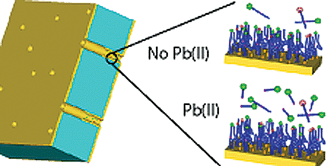A Pb(II)-specific DNAzyme has been successfully incorporated into Au-coated polycarbonate track-etched (PCTE) nanocapillary array membranes (NCAMs) by thiol–gold immobilization. Incorporation of the DNAzyme into the membrane provides a substrate-bound sensor using a novel internal control methodology for fluorescence-based detection of Pb(II). A non-cleavable substrate strand, identical to the cleavable DNAzyme substrate strand except the RNA-base is replaced by the corresponding DNA-base, is used for ratiometric comparison of intensities. The cleavable substrate strand is labeled with fluorescein, and the non-cleavable strand is labeled with a red fluorophore (Cy5 or Alexa 546) for detection after release from the membrane surface. This internal standard based ratiometric method allows for real-time monitoring of Pb(II)-induced cleavage, as well as standardizing variations in substrate size, solution detection volume, and monolayer density. The result is a Pb(II)-sensing structure that can be stored in a prepared state for 30 days, regenerated after reaction, and detect Pb(II) concentrations as low as 17 nM (3.5 ppb).

You have access to this article
 Please wait while we load your content...
Something went wrong. Try again?
Please wait while we load your content...
Something went wrong. Try again?


 Please wait while we load your content...
Please wait while we load your content...